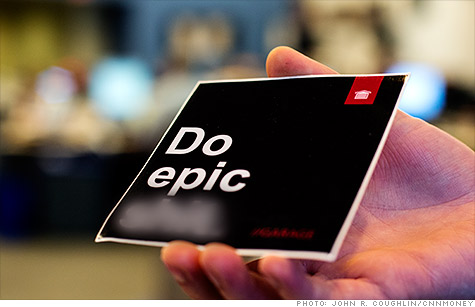Search News

This sticker touts one of Microsoft Research's unofficial slogans: "Do epic $%#!"
REDMOND, Wash. (CNNMoney) -- Microsoft is notoriously laser-focused on products, limiting its creative thinkers to ideas that will keep the Windows and Office profit machines churning.
That narrow obsession is what has sustained Microsoft's remarkable financial success for more than three decades. It's also the obstacle that made it a runner-up to Apple (AAPL, Fortune 500), Google (GOOG, Fortune 500) and Facebook (FB) in crucial consumer categories like smartphones, tablets, music, media, search, and social networking.
Even Microsoft (MSFT, Fortune 500) Kool-Aid drinkers have to admit that the once-revolutionary software maker has been out-innovated on too many fronts over the past decade.
That's why Microsoft set up a large but under-the-radar research division outside of any of its product groups. It's where some of the world's brightest minds are let loose to invent just about anything they'd like -- regardless of how it fits in with the company's business strategy. Microsoft Research is where the company's legendary red tape goes to die.
The result: The division's 850 researchers are creating some truly mind-blowing stuff.
"We're one of the only basic research groups in world with free reign to push the boundaries of science and technology," says Kevin Schofield, chief operating officer of MSR. "It's designed to make sure our researchers see as little bureaucracy as possible."
That freedom has sparked now-in-development projects like a robot that goes to work for you, motion control technology for laptops, 1,300-inch HD screens, and even a tiny butterfly that measures your blood pressure.
If any one of those projects turns into an actual product, Microsoft has the chance to lead a new market ahead of its rivals.
Here's the catch: That rarely happens. Microsoft Research has been in operation since 1991, and Microsoft still is getting its butt kicked in pretty much every consumer category not named PCs, productivity software or video games.
The company's biggest obstacle is usually itself.
Microsoft CEO Steve Ballmer famously killed off a tablet product eerily similar to the iPad years before the Apple tablet's debut. Microsoft has little to show for all the resources it poured into the doomed "Courier" project -- while Apple collected $9.2 billion in sales last quarter from the iPad alone.
Microsoft was an early developer of touchscreen technology, but it stuck by its stylus-based smartphone software and watched the iPhone and Android zoom past it.
Microsoft Research engineers invented the basic motion-control technology behind the hot-selling Kinect in 1998, but Microsoft didn't integrate it into a product until 2010. And Vanity Fair's recent, scathing report on Microsoft's "lost decade" noted that the company developed an e-reader a decade before the Amazon (AMZN, Fortune 500) Kindle. Then-CEO Bill Gates shut it down.
The list goes on.
There's a constant theme uniting each of the potentially game-changing products that was killed off before it saw daylight: They had little to do with Windows or Office.
Microsoft Research may boast about its "no red tape" ethos, but the group's scientists aren't the ones with the resources to turn their inventions into products. The divisions in charge of that are loaded with bureaucracy.
The good news for Microsoft is that there are a few promising signals that the company's ossified culture may finally be evolving.
The Surface tablet, with its innovative keyboard, essentially blew up Microsoft's tried-and-true "let others make the hardware" PC business model. The upcoming Windows 8 is a complete redesign of both the operating system's user interface and the open app model that helped Windows gain more than 90% of the PC market.
Those steps have the Microsoft Research team feeling more optimistic that some of its projects might ultimately land on store shelves.
"People who work here are here because they want to see their stuff end up in customers' hands," Schofield said. "We're always asking ourselves: How do we push boundaries faster? And how do we bring this to market?"
CNNMoney got a tour of the Microsoft Research lab and its pipeline of prototypes. They projects we saw are futuristic and undeniably cool. We'll be featuring stories and videos this week on some of the most intriguing.
Here's the question we can't answer: Will any of these see the light of day?
If Microsoft wants to remain one of the tech industry's Goliaths, it has to find a way to connect its innovators and their creations with the rest of the world.
Inside Microsoft's research lab, part 1: Your wallpaper could soon be an HD display ![]()